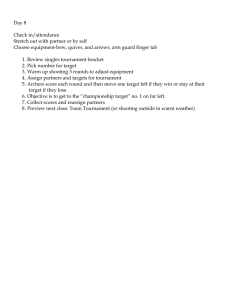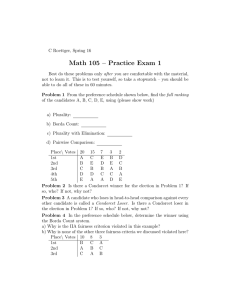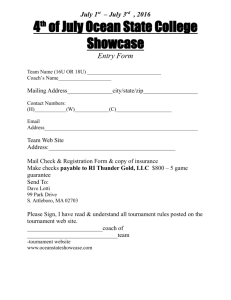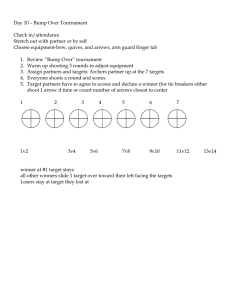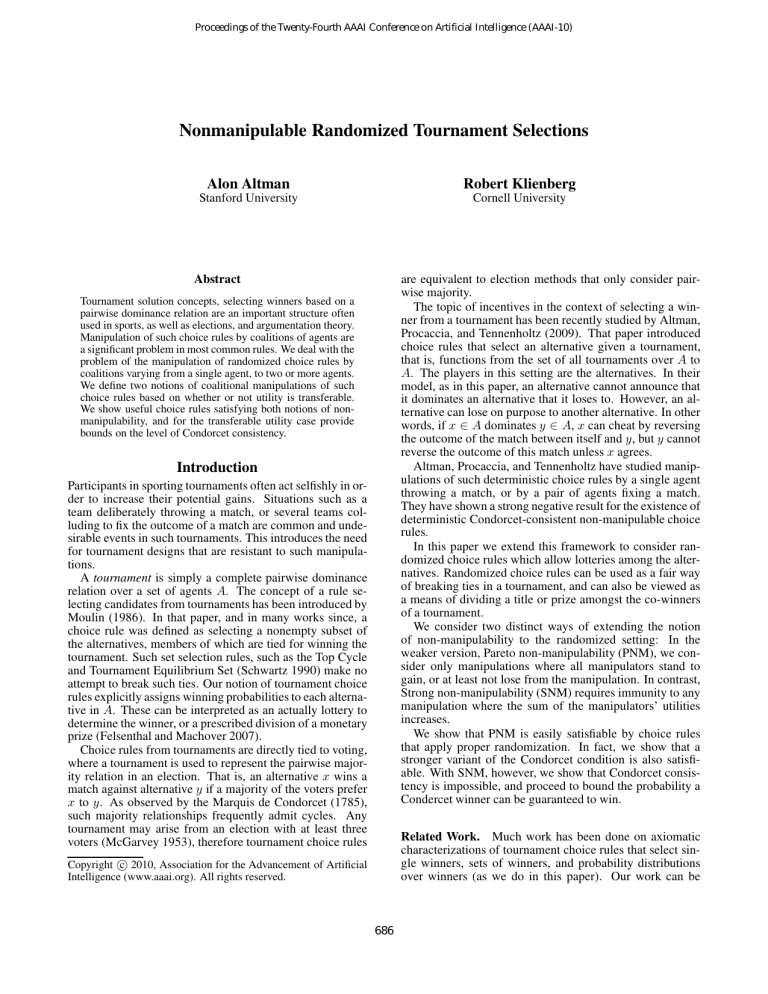
Proceedings of the Twenty-Fourth AAAI Conference on Artificial Intelligence (AAAI-10)
Nonmanipulable Randomized Tournament Selections
Alon Altman
Robert Klienberg
Stanford University
Cornell University
Abstract
are equivalent to election methods that only consider pairwise majority.
The topic of incentives in the context of selecting a winner from a tournament has been recently studied by Altman,
Procaccia, and Tennenholtz (2009). That paper introduced
choice rules that select an alternative given a tournament,
that is, functions from the set of all tournaments over A to
A. The players in this setting are the alternatives. In their
model, as in this paper, an alternative cannot announce that
it dominates an alternative that it loses to. However, an alternative can lose on purpose to another alternative. In other
words, if x ∈ A dominates y ∈ A, x can cheat by reversing
the outcome of the match between itself and y, but y cannot
reverse the outcome of this match unless x agrees.
Altman, Procaccia, and Tennenholtz have studied manipulations of such deterministic choice rules by a single agent
throwing a match, or by a pair of agents fixing a match.
They have shown a strong negative result for the existence of
deterministic Condorcet-consistent non-manipulable choice
rules.
In this paper we extend this framework to consider randomized choice rules which allow lotteries among the alternatives. Randomized choice rules can be used as a fair way
of breaking ties in a tournament, and can also be viewed as
a means of dividing a title or prize amongst the co-winners
of a tournament.
We consider two distinct ways of extending the notion
of non-manipulability to the randomized setting: In the
weaker version, Pareto non-manipulability (PNM), we consider only manipulations where all manipulators stand to
gain, or at least not lose from the manipulation. In contrast,
Strong non-manipulability (SNM) requires immunity to any
manipulation where the sum of the manipulators’ utilities
increases.
We show that PNM is easily satisfiable by choice rules
that apply proper randomization. In fact, we show that a
stronger variant of the Condorcet condition is also satisfiable. With SNM, however, we show that Condorcet consistency is impossible, and proceed to bound the probability a
Condercet winner can be guaranteed to win.
Tournament solution concepts, selecting winners based on a
pairwise dominance relation are an important structure often
used in sports, as well as elections, and argumentation theory.
Manipulation of such choice rules by coalitions of agents are
a significant problem in most common rules. We deal with the
problem of the manipulation of randomized choice rules by
coalitions varying from a single agent, to two or more agents.
We define two notions of coalitional manipulations of such
choice rules based on whether or not utility is transferable.
We show useful choice rules satisfying both notions of nonmanipulability, and for the transferable utility case provide
bounds on the level of Condorcet consistency.
Introduction
Participants in sporting tournaments often act selfishly in order to increase their potential gains. Situations such as a
team deliberately throwing a match, or several teams colluding to fix the outcome of a match are common and undesirable events in such tournaments. This introduces the need
for tournament designs that are resistant to such manipulations.
A tournament is simply a complete pairwise dominance
relation over a set of agents A. The concept of a rule selecting candidates from tournaments has been introduced by
Moulin (1986). In that paper, and in many works since, a
choice rule was defined as selecting a nonempty subset of
the alternatives, members of which are tied for winning the
tournament. Such set selection rules, such as the Top Cycle
and Tournament Equilibrium Set (Schwartz 1990) make no
attempt to break such ties. Our notion of tournament choice
rules explicitly assigns winning probabilities to each alternative in A. These can be interpreted as an actually lottery to
determine the winner, or a prescribed division of a monetary
prize (Felsenthal and Machover 2007).
Choice rules from tournaments are directly tied to voting,
where a tournament is used to represent the pairwise majority relation in an election. That is, an alternative x wins a
match against alternative y if a majority of the voters prefer
x to y. As observed by the Marquis de Condorcet (1785),
such majority relationships frequently admit cycles. Any
tournament may arise from an election with at least three
voters (McGarvey 1953), therefore tournament choice rules
Related Work. Much work has been done on axiomatic
characterizations of tournament choice rules that select single winners, sets of winners, and probability distributions
over winners (as we do in this paper). Our work can be
Copyright c 2010, Association for the Advancement of Artificial
Intelligence (www.aaai.org). All rights reserved.
686
seen as contributing to this body of work by considering
incentive-based axioms, i.e. nonmanipulability. For a detailed review of this research see (Laslier 1997).
In the context of elections, nonmanipulability of randomized voting rules has been shown to practically impossible
(Gibbard 1977). That is, if there are at least three alternatives, any nonmanipulable voting rule must be a mixture of
ones that are unilateral, i.e. dictatorships, and those that are
duple, i.e. restrictive to a pair of outcomes. Our work on
manipulability is inherently different, as in our case the manipulators are the alternatives who can collude to increase
the chances of any or all of them winning. Moreover, Gibbard (1977) considers general voting rules from preference
profiles to distributions on candidates, while our tournament
solutions are limited to working on the pairwise dominance
relation.
An example of a paper that directly studies manipulation
of tournament choice rules is the work of Dutta, Jackson,
and Le Breton (2002). They examined a specific class of
choice rules, in the context of voting. Specifically, Dutta,
Jackson, and Le Breton investigated a setting where alternatives can decide whether or not to enter the election; they
characterize the set of alternatives that can be outcomes of
the election in equilibrium.
We observe that any choice rule can be made into an
anonymous choice rule by randomly permuting the names
of the alternatives before applying a choice rule. Therefore,
in the remainder of this paper we will implicitly limit our
discussion to anonymous choice rules.
We would expect a desirable choice rule to use randomization only when there is some kind of tie for winner. In
particular, we would like a clear-cut winner, which beats all
other participants to always win the tournament.
Definition 3. Alternative x is a Condorcet winner in T ∈ T
if xT y for all y ∈ A \ {x}.
A tournament choice rule r is called Condorcet consistent
if for all T ∈ T such that c is a Condorcet winner in T :
rT (c) = 1.
Similarly, we can define the notion of a Condorcet loser,
which should never win a tournament:
Definition 4. Alternative x is a Condorcet loser in T ∈ T
if yT x for all y ∈ A \ {x}.
A tournament choice rule r is called Condorcet loser consistent (CLC) if for all T ∈ T such that c is a Condorcet
loser in T : rT (c) = 0.
Our main focus in this paper is resistance to manipulations
by a pair of participants. Such manipulations involve the
flipping of an edge in the tournament graph. This brings rise
to the following definition of adjacency:
Structure of the paper. We begin by formally defining
the notions of tournaments, choice rules, and manipulations.
In the following sections we present our results of Pareto
and strong manipulations. Finally, we conclude and provide
directions for future research.
Definition 5. We say that T and T ′ are S-adjacent for some
S ⊆ A if and only if the two tournaments disagree only on
edges in S, that is for all {z, w} 6⊆ S: zT w ⇔ zT ′w.
The most simple manipulation a single participant may
consider is throwing a match, that is losing a match they
could have won. Resistance to this kind of manipulation
coincides with the well-known property of monotonicity,
which means winning a match cannot reduce the winner’s
probability of winning the tournament.
Tournaments and Manipulations
Let A be a set of alternatives. A tournament T over A is a
complete asymmetric binary relation over A. In other words,
for every two distinct alternatives x, y ∈ A, exactly one of
the following holds: xT y (read: x dominates y), or yT x.
We denote the set of tournaments over A by T .
A common visual way to represent tournaments is via
graphs. A tournament T ∈ T corresponds to a directed
graph G = (V, E), where V = A, and the directed edge
from x to y is in E if and only if xT y. In other words, G
is an orientation of the complete graph on A. In the sequel
we will use the terms alternatives, participants, nodes, and
agents interchangeably.
We can now define our main focus of this paper: tournament choice rules.
Definition 6. A choice rule r is monotonic if and only if for
all T 6= T ′ ∈ T that are {x, y}-adjacent and xT y: rT (x) ≥
rT ′ (x). Such a rule is strictly monotonic if these inequalities
are strict.
When considering manipulations by a pair of participants,
we consider two distinct utility models. When utility is not
transferable, a manipulation is valid only if neither of the
manipulators are worse off and at least one of the manipulators is better off. We call this Pareto Manipulation:
Definition 7. A choice rule r is Pareto non-Manipulable
for coalitions of size k (k-PNM) if for every S ⊆ A such
that |S| ≤ k and for every T, T ′ ∈ T that are S-adjacent:
∃x ∈ S : rT (x) > rT ′ (x) or ∀x ∈ S : rT (x) ≥ rT ′ (x). We
say that r is PNM if it is k-PNM for any k ∈ N.
Definition 1. A choice rule is a mapping r : T 7→ ∆(A ∪
{ε}) that maps each tournament to a probability distribution over the alternatives, with a possibility of selecting no
alternative (ε). A tournament choice rule is called strict if
rT (ε) = 0 for all T ∈ T . A tournament choice rule is called
deterministic if rT (a) ∈ {0, 1} for all T ∈ T and a ∈ A.
If we assume transferable utility, a much stronger manipulation resistance is required, as the manipulators only care
about their combined probability of winning the tournament:
A simple requirement from a randomized choice rule is
to be independent of the names of the alternatives. This requirement is reasonable since ties could always be broken
using randomization.
Definition 8. A choice rule r is Strongly non-Manipulable
for coalitions of size k (k-SNM) if for every S ⊆ A such
′
that
P |S| ≤ k andPfor every T, T ∈ T that are S-adjacent:
′
r
(x)
=
r
(x).
We
say that r is SNM if it is
x∈S T
x∈S T
k-SNM for any k.
Definition 2. A choice rule r is called anonymous if for every tournament T ∈ T and for every permutation π of A:
π(rT ) ≡ rπ(T ) .
687
Note that in the case of deterministic choice rules the
above definitions of non-manipulability are equivalent, and
both variants of non-manipulability are extensions of the
non-manipulability property for deterministic choice rules.
Pareto Manipulation
When restricting our attention to Pareto manipulations
where all manipulators must gain from the manipulation, the
use of strict randomized choice rules allows to easily obtain
Condorcet consistency in addition to other desirable properties.
The intuition behind Condorcet consistency can be extended to any tournament using the concept of a top cycle:
Definition 9. A set of alternatives C ⊆ A is the top cycle in
T ∈ T [notation: C = T C(T )] if for all x ∈ C, y ∈ A \ C:
xT y and C is the minimal such set.
The top cycle is well-defined since the set of all alternatives A satisfies the condition and the minimal set is unique.
We can now define the following special case of Condorcet
consistency.
Definition 10. A choice rule r satisfies the top cycle condition (TCC) if for every tournament T ∈ T : rT (x) > 0
implies x ∈ T C(T ). r further satisfies the strong top cycle condition if for every tournament T : x ∈ T C(T ) also
implies rT (x) > 0.
Another useful property of a choice rule is consistent behavior between different sizes of tournaments.
Definition 11. A choice rule r satisfies the Condorcet loser
removal condition (CLR) if for every tournament T ∈ T
such that there exists a Condorcet loser c ∈ A: rT ≡ rT \{c} .
That is, r assigns the same probability distribution for T and
T where c is removed.
Note that for strict choice rules, the CLR implies that a
Condorcet loser must be chosen with zero probability.
We shall now present several examples of strict choice
rules that satisfy 2-PNM, monotonicity, strong TCC, and
CLR:
• The Iterative Condorcet rule (ICR) is defined algorithmically as follows: Let T be the input tournament. If x is
a Condorcet winner in T output x and stop. Otherwise,
remove a random alternative y ∈ A and repeat.
• The Randomized Voting Caterpillar (RVC) selects a random permutation π of A and then selects the winner of the
voting caterpillar defined by π. That is, the winner of iterative pairwise matches between the previous winner and
next participant according to π. See (Fischer, Procaccia,
and Samorodnitsky 2009) for a formal definition.
• The Top Cycle Rule (TCR) simply assigns probability
1
|T C(T )| for all elements in T C(T ) and zero otherwise.
(a) T
Figure 1: Size 4 tournament with no Condorcet winner or
loser
We shall now prove the properties of these choice rules:
Proposition 12. ICR, RVC, and TCR satisfy 2-PNM, monotonicity, strong TCC, and CLR. Moreover, TCR satisfies
PNM while ICR and RVC do not satisfy 3-PNM.
Proof. (Sketch) Monotonicity of the ICR and RVC is a direct result of each of the rules being randomized on are
monotone. Monotonicity of TCR is due to the fact that reversing an edge may never decrease the size of the top cycle without removing the loser from the top cycle, and may
never allow the loser into the top cycle unless it was already
in the top cycle.
Strong TCC is satisfied by TCR by definition. ICR and
RVC also satisfy strong TCC due to the fact that only members of the top cycle may be selected (since once all but one
of the top cycle members are removed the remaining member is a Condorcet winner), and due to the minimality of the
top cycle there exists a RVC and a removal strategy such that
each member of the top cycle is selected.
All the choice rules satisfy CLR because they are defined
solely based on the top cycle.
ICR and RVC satisfy 2-PNM since they are both strictly
monotone within the top cycle. Therefore, any edge that is
flipped within such that the loser was in the top cycle will
strictly reduce the probability of the loser being chosen, and
hence such a manipulation is not possible. An edge flipped
outside the top cycle obviously has no effect.
To see TCR satisfies PNM, note that a successful manipulation must either reduce the size of the top cycle while
all coalition members remain within, or add a new manipulator to the top cycle while keeping the top cycle of the
same size. Both cases require the manipulators to remove a
non-manipulator from the top cycle. For that to happen, all
alternatives directly or indirectly dominated by that manipulator must also be removed from the top cycle, and this is
only possible if at least one manipulator is removed from the
top cycle, in contradiction to PNM.
RVC does not satisfy 3-PNM since in the tournament T
in Figure 1a, a manipulation by {b, c, d} could manipulate
the tournament to tournament T ′ in Figure 1b, where (due
to symmetry) rT ′ (b) = rT (c) = 41 = rT (b), rT ′ (c) =
5
1
rT (a) = 12
> rT (c), rT ′ (d) = rT (d) = 12
.
To show ICR does not satisfy 3-PNM we must look at a
tournament of size at least 6 (see Figure 2). Here, {a, b, c}
can manipulate by flipping their internal edges. Specifically,
The three rules defined above are all different. For example,
for four alternatives, the rules assign the following probabilities in the tournament T where no Condorcet winner nor
loser exist (Figure 1a):
5
1
1
1
12 , rT (b) = 3 , rT (c) = 6 , rT (d) = 12 .
5
1
= 12
, rT (b) = 14 , rT (c) = 14 , rT (d) = 12
.
1
1
1
1
= 4 , rT (b) = 4 , rT (c) = 4 , rT (d) = 4 .
• ICR: rT (a) =
• RVC: rT (a)
• TCR: rT (a)
(b) T ′
688
Proof. Assume for contradiction choice rule r satisfying the
conditions of the theorem. Let T be a tournament of size n
where for all i < j ∈ A: jT i. Consider any three agents
i − 1, i, i + 1 ∈ A. Consider the tournament T ′ which is
{i − 1, i + 1}-adjacent to T such that (i − 1)T ′ (i + 1). This
manipulation creates a 3-cycle in the graph: iT ′ (i−1)T ′(i+
1)T ′ i, where agents i − 1, i, i + 1 are completely symmetric.
Since this is a manipulation by i − 1 and i + 1, we have
rT ′ (i + 1) + rT ′ (i − 1) = rT (i + 1) + rT (i − 1), and by
symmetry rT ′ (i+1) = rT ′ (i−1) = 12 [rT (i+1)+rT (i−1)].
However, this could also be seen as a manipulation by the
trio (i−1, i, i+1), and hence 2rT (i) = rT (i+1)+rT (i−1).
Compounded with the fact that the sum of all rT (i) must
be ≤ 1, we get that rT (n) ≤ 2/n, in contradiction to our
assumption.
Figure 2: 3-Manipulable tournament for ICR
this manipulation strictly increases the probability of all of
these alternatives.
For coalitions of size 2, we know the following upper
bound on α:
Proposition 17. There exist no 2-SNM choice rules that
have Condorcet-consistency value α > 32 .
Strong Non-manipulability
In this section we discuss the stronger notion of manipulations where utility is transferable. We begin by noting that
the impossibility theorem of Altman, Procaccia, and Tennenholtz (2009) for deterministic rules equally applies to
strongly non-manipulable randomized rules.
Proof. Assume for contradiction a choice rule r that satisfies
the requirements, and consider a tournament T of arbitrary
size n with a top cycle of three elements {a, b, c}. Any pair
of these elements may manipulate to make one of them a
Condorcet winner, gaining at least α. Hence,
Proposition 13. There exist no 2-SNM Condorcetconsistent choice rules.
This impossibility result requires us to weaken either
the non-manipulability or Condorcet-consistency requirement. We have already discussed a weaker version of nonmanipulability, therefore we will now focus on choice rules
that are approximately Condorcet consistent. Specifically,
we aim to maximize the approximation ratio while maintaining nonmanipulability.
>
rT (a) + rT (c)
>
rT (b) + rT (c)
>
2
3
2
3
2
,
3
and therefore rT (a) + rT (b) + rT (c) > 1, which is a contradiction.
Definition 14. A choice rule r has Condorcet consistency
value α : N 7→ [0, 1] if for all T ∈ T such that c is a
Condorcet winner in T : rT (c) ≥ α(|A|).
Given a tournament size n, the problem of finding a
choice rule with a maximal Condorcet consistency value for
2-SNM tournaments of that size could be expressed as a linear program:
The following simple choice rule could serve as a lower
bound for the Condorcet consistency value of SNM choice
rules.
max
piT − α ≥
piT + pjT
−piT ′ − pjT ′ =
X
piT ≤
Proposition 15. There exists a SNM, strictly monotone,
CLC, strict choice rule which has Condorcet consistency
value of n2 .
Proof. The required choice rule simply selects two alternatives uniformly at random, and then chooses the winner of
the pairwise match between them. Equivalently, every alternative is chosen with probability
rT (x) =
rT (a) + rT (b)
α s.t.
0 if i is the Condorcet winner in T
0 where T, T ′ are {i, j}-adjacent
1 ∀T
i
piT
≥
0 ∀i, T
Additional constraints such as strictness, monotonicity, and
CLC could also be expressed in this linear program:
X
piT = 1 ∀T
2
· |{y : xT y}|.
n(n − 1)
The required conditions are trivially satisfied.
i
piT − piT ′
piT
Theorem 16. There exists no choice rule that is 3-SNM and
has a Condorcet consistency value α > n2 .
The size of the aforementioned LP could be significantly
reduced by requiring the rule to be anonymous, and hence
689
≥
=
0 where T, T ′ are {i, j}-adjacent and iT j
0 if i is the Condorcet loser in T
This lower bound is tight in the case where nonmanipulability is required for coalitions of size 3:
Strict CLC
no
no
no
no
no
yes
no
yes
yes
no
yes
no
yes
yes
yes
yes
Lower Bound
Mon.
no
yes
no
yes
no
yes
no
yes
3
4
2/3
2/3
2/3
2/3
2/3
2/3
2/3
2/3
2/3
1/2
2/3
1/2
2/3
1/2
2/3
1/2
2/3
1/2
5
0.6548
0.6471
0.6471
0.6471
0.5667
0.5333
0.4667
0.4667
2/5
6
0.6548
0.6471
0.6472
0.6471
0.6196
0.5513
0.5375
1/2
1/3
Conclusions and Future Work
In this paper we have expanded the notion of nonmanipulable tournament choice rules to encompass two major extensions: First, we discuss randomized choice rules, which may
assign varying weights for each alternative to win, or even
make no choice at all. Second, we consider manipulations
by coalitions of more than only two agents.
We have presented two different notions of manipulation
that are consistent with the deterministic case. The weaker
notion, Pareto Non-Manipulability, could be easily attained,
even for coalitions of arbitrary size, by allocating positive
probability to all alternatives in the top cycle of the tournament.
Our stronger notion of manipulation is still always possible when the choice rule can be randomized, and hence we
are forced to weaken Condorcet consistency. However, unlike the deterministic case, we can attempt to maximize the
probability of a Condorcet winner being selected. We have
shown a tight bound for manipulations by coalitions of three
or more agents, and have experimentally explored manipulations by pairs of agents.
Many open questions still remain. For Pareto manipulations, finding a classification theorem for nonmanipulable
choice rules, both for pairs and for arbitrary size coalitions,
is still an open problem. For strong manipulations, a gap still
remains between the lower bound for Condorcet consistency
of n2 and the known upper bound of 23 .
Table 1: Best obtainable Condorcet consistency values under various restrictions
Acknowledgments
Figure 3: Best obtainable Condorcet consistency values under various restrictions
The authors would like to thank Ariel Procaccia, Jon Kleinberg, and Moshe Tennenholtz for useful discussions.
References
we could define variables and rules only once for each structurally unique tournament.
Using an LP solver to solve these LPs for small values of
n, we see that the aforementioned lower bound of n2 is tight
for n = 3, and for n = 4 when strictness is required. Even
more surprisingly, for larger values of n the empirically calculated best value for α is larger than 21 , even when strictness
is enforced. Best obtainable α values for n = 3, 4, 5, 6 can
be seen in Table 1 and Figure 3.
Our experimental results show that at least for small values of n, the 32 upper bound is nearly attainable when not
requiring strict choice rules, even though it could not be
reached for n > 4. When strictness is required these values vary significantly with n but seem to be well over the n2
lower bound.
A specific interesting randomized non-strict choice rule
for n = 4 allows for an α value of 23 . This rule is defined as
follows: If a Condorcet winner exists, is selected with probability of 23 , and no alternative is selected with probability 13 .
In the case where there is a top-cycle of three alternatives,
all get chosen with probability 13 . In the remaining case, the
probabilities are assigned according to RVC. That is, for Fig5
ure 1a, the rankings are rT (a) = 12
, rT (b) = rT (c) = 14 ,
1
rT (d) = 12 . Any pair of agents that can become a Condorcet winner or two members of a 3-top cycle sum up to
2
3 , as required, and any pair that can become a member of a
3-top cycle and a Condorcet loser sum up to 31 .
Altman, A.; Procaccia, A.; and Tennenholtz, M. 2009. Nonmanipulable selections from a tournament. In Proc. 21st International
Joint Conference on Artificial Intelligence.
de Condorcet, M. 1785. Essai sur l’application de l’analyse à la
probabilité de décisions rendues à la pluralité de voix. Imprimerie
Royal. Facsimile published in 1972 by Chelsea Publishing Company, New York.
Dutta, B.; Jackson, M. O.; and Le Breton, M. 2002. Voting by successive elimination and strategic candidacy. Journal of Economic
Theory 103:190–218.
Felsenthal, D., and Machover, M. 2007. After two centuries,
should condorcet’s voting procedure be implemented? Behavioral
Science 37(4):250–274.
Fischer, F.; Procaccia, A. D.; and Samorodnitsky, A. 2009. A
new perspective on implementation by voting trees. In EC ’09:
Proceedings of the tenth ACM conference on Electronic commerce,
31–40. New York, NY, USA: ACM.
Gibbard, A. 1977. Manipulation of schemes that mix voting with
chance. Econometrica 45:665–681.
Laslier, J.-F. 1997. Tournament Solutions and Majority Voting.
Springer.
McGarvey, D. C. 1953. A theorem on the construction of voting
paradoxes. Econometrica 21:608–610.
Moulin, H. 1986. Choosing from a tournament. Social Choice and
Welfare 3:271–291.
Schwartz, T. 1990. Cyclic tournaments and cooperative majority
voting: A solution. Social Choice and Welfare 7(1):19–29.
690

